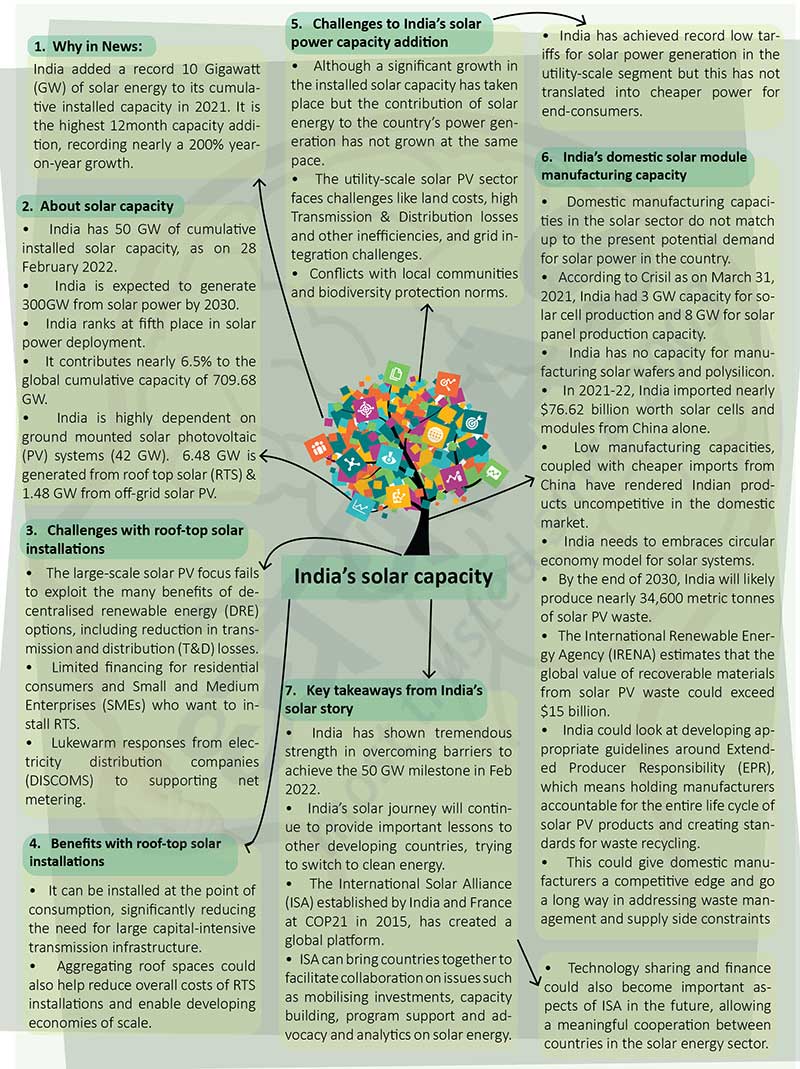Brain-booster
/
19 Apr 2022
Brain Booster for UPSC & State PCS Examination (Topic: India’s Solar Capacity)

Why in News?
- India added a record 10 Gigawatt (GW) of solar energy to its cumulative
installed capacity in 2021. It is the highest 12month capacity addition,
recording nearly a 200% yearon- year growth.
About solar capacity
- India has 50 GW of cumulative installed solar capacity, as on 28
February 2022.
- India is expected to generate 300GW from solar power by 2030.
- India ranks at fifth place in solar power deployment.
- It contributes nearly 6.5% to the global cumulative capacity of 709.68
GW.
- India is highly dependent on ground mounted solar photovoltaic (PV)
systems (42 GW). 6.48 GW is generated from roof top solar (RTS) & 1.48 GW
from off-grid solar PV.
Challenges with roof-top solar installations
- The large-scale solar PV focus fails to exploit the many benefits of
decentralised renewable energy (DRE) options, including reduction in
transmission and distribution (T&D) losses.
- Limited financing for residential consumers and Small and Medium
Enterprises (SMEs) who want to install RTS.
- Lukewarm responses from electricity distribution companies (DISCOMS) to
supporting net metering.
Benefits with roof-top solar installations
- It can be installed at the point of consumption, significantly reducing
the need for large capital-intensive transmission infrastructure.
- Aggregating roof spaces could also help reduce overall costs of RTS
installations and enable developing economies of scale.
Challenges to India’s solar power capacity addition
- Although a significant growth in the installed solar capacity has taken
place but the contribution of solar energy to the country’s power generation
has not grown at the same pace.
- The utility-scale solar PV sector faces challenges like land costs, high
Transmission & Distribution losses and other inefficiencies, and grid
integration challenges.
- Conflicts with local communities and biodiversity protection norms.
- India has achieved record low tariffs for solar power generation in the
utility-scale segment but this has not translated into cheaper power for
end-consumers.
India’s domestic solar module manufacturing capacity
- Domestic manufacturing capacities in the solar sector do not match up to
the present potential demand for solar power in the country.
- According to Crisil as on March 31, 2021, India had 3 GW capacity for
solar cell production and 8 GW for solar panel production capacity.
- India has no capacity for manufacturing solar wafers and polysilicon.
- In 2021-22, India imported nearly $76.62 billion worth solar cells and
modules from China alone.
- Low manufacturing capacities, coupled with cheaper imports from China
have rendered Indian products uncompetitive in the domestic market.
- India needs to embraces circular economy model for solar systems.
- By the end of 2030, India will likely produce nearly 34,600 metric
tonnes of solar PV waste.
- The International Renewable Energy Agency (IRENA) estimates that the
global value of recoverable materials from solar PV waste could exceed $15
billion.
- India could look at developing appropriate guidelines around Extended
Producer Responsibility (EPR), which means holding manufacturers accountable
for the entire life cycle of solar PV products and creating standards for
waste recycling.
- This could give domestic manufacturers a competitive edge and go a long
way in addressing waste management and supply side constraints.
Key takeaways from India’s solar story
- India has shown tremendous strength in overcoming barriers to achieve
the 50 GW milestone in Feb 2022.
- India’s solar journey will continue to provide important lessons to
other developing countries, trying to switch to clean energy.
- The International Solar Alliance (ISA) established by India and France
at COP21 in 2015, has created a global platform.
- ISA can bring countries together to facilitate collaboration on issues
such as mobilising investments, capacity building, program support and
advocacy and analytics on solar energy.
- Technology sharing and finance could also become important aspects of
ISA in the future, allowing a meaningful cooperation between countries in
the solar energy sector.







